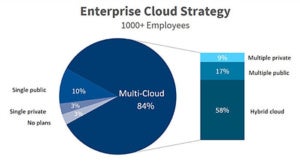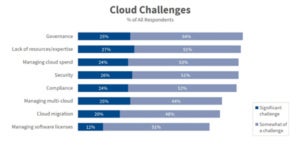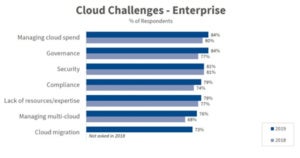advertisement
The ugly truth about cloud computing in the enterprise
One surprising finding of Flexera’s RightScale 2019 State of the Cloud report is that 84 percent of enterprises surveyed have a multicloud strategy. No,…

One surprising finding of Flexera’s RightScale 2019 State of the Cloud report is that 84 percent of enterprises surveyed have a multicloud strategy. No, it’s not surprising that the number is so high. Rather, it’s surprising that the number isn’t 100 percent. After all, the cloud has been driven by developer convenience, and those same developers are choosing services from different clouds, running them throughout an enterprise.
It’s a convenient fiction that enterprises meant for this sprawling cloud mess to happen.
It’s the cloud all the way down to the data center
RightScale polled 786 cloud professionals to figure out adoption trends. As shown in Flexera’s data, enterprises are a bit all over the map in terms of cloud strategy.
advertisement
 FLEXERA
FLEXERAWhile all areas of cloud are growing, public cloud adoption vastly outpaces private cloud, and the mingling of both public and private cloud (hybrid cloud) beats them both as single phenomenon. This makes sense, because companies are going big with public cloud but need to find ways to rationalize those investments against the sunk costs of their private data centers.
The primacy of public cloud in this hybrid mix becomes clear in a Credit Suisse CIO survey, which found that the Big 3 hybrid cloud vendors are Amazon Web Services, Microsoft Azure, and Google Cloud Platform—that is, the Big 3 public cloud providers. It’s also telling that 51 percent of these same respondents told Credit Suisse that they would be shutting down most or at least a few of their data centers of the next several years.
advertisement
But this is where things stop to make sense.
Enterprise cloud teams: Where’s the governance?
While 94 percent of the companies RightScale surveyed claim to be running workloads in the cloud, few of them seem to be doing it particularly well. They may tout their hybrid cloud “strategy,” for example, but when asked what their biggest challenges were, the answer was “We can’t seem to get a handle on all this adoption”—despite the fact that 66 percent of those surveyed said they have a central cloud team, according to the Flexera survey.
 FLEXERA
FLEXERABetween a lack of governance and ability to keep cloud costs in control is perhaps the root of it all: a lack of qualified personnel. Or, spun a different way, these enterprises may have plenty of qualified AWS, Azure, or GCP personnel, but they’re all running siloed applications in siloed cloud deployments in the enterprise. On average, enterprises are running five clouds, spread between private and public clouds. If that sounds like “strategy,” well, you’re not paying attention.
advertisement
Oh, and by the way, the problems are only getting worse, according to the Flexera survey.
 FLEXERA
FLEXERAAgain, if you’ve ever worked in a large enterprise, none of these findings will surprise you. Nor will it shock you to discover that by far the biggest priority for these organizations is to make better use (and wring cost savings from) existing clouds, rather than to chase down new services at new clouds.
Finally, it should shock no one that surveying CIOs to uncover the “strategy” driving cloud adoption is a bit of a lost cause. Developers are the ones spinning up cloud infrastructure to support applications they’re building. CIOs may try to rationalize this after the fact as a multicloud or hybrid strategy, but it’s really just an echo of something Billy Marshall said years ago, with reference to open source adoption: The CIO is the last to know.
A longtime InfoWorld contributor and former intellectual property lawyer, Matt Asay is currently Head of Developer Ecosystem at Adobe at Adobe. The views expressed are his own and not that of his employer.